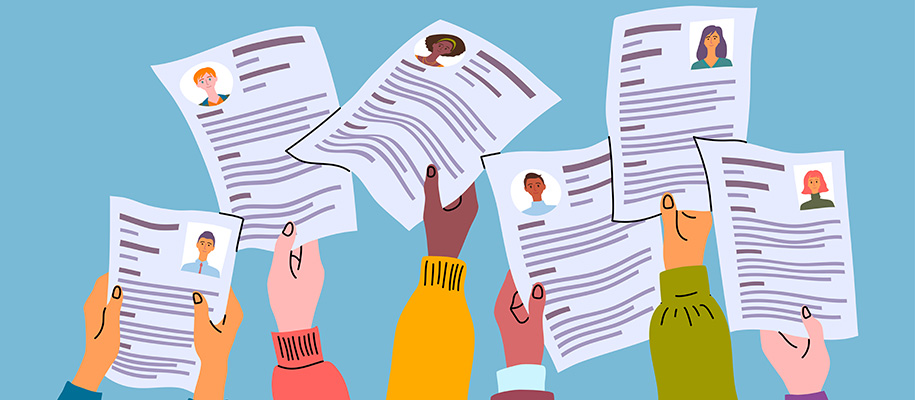Whether you're a recent college grad who's new to the job search or a seasoned professional looking for a change, the first step to finding a job is having a fantastic résumé. The purpose of this document is to make the reader want to interview you. Résumés should be informative, concise, and consistent, and they should highlight intriguing skills and experience. You want it to grab an employer's attention early and provide a concentrated, convincing argument that you perfectly match the position at hand. This guide will walk you through writing a great professional résumé and what you can do to make it stand out among a sea of other applicants. Here's everything you need to know.
Résumé basics
Those who've been in the workforce for several years would customarily list professional experience first, followed by education and other elements such as publications or skills. Most résumés use reverse chronological order, listing the most recent experience first with the rest following chronologically. This type of résumé gives a prospective employer a sense of where your career is headed and how it evolved into what it is today. For entrepreneurs, sales personnel, recent graduates, and others with less-than-standard experience, an alternative format called the functional approach might make more sense. This format puts an emphasis on your abilities and achievements, categorizing your experience by industry, type of position, skill, and what you did rather than when you did it.
There's no right or wrong way to write a résumé. Whatever sets you apart from the masses while requiring a minimum of effort for the recruiter will probably be your best bet. Here are some general guidelines to follow.
- Be concise. Unless you have been working for a long time, stick to one page. Even with extensive experience, a résumé should rarely exceed two pages.
- Use vivid language. Include hard facts showing your impact on the company. Employers want to know what you did and how closely that experience matches their needs. Use action verbs and eliminate pronouns. Be grammatically consistent and proofread rigorously for mistakes.
- Go easy on the eye. Graphics in a résumé should make it easy to read. Use topic headings and lots of space. Forget clip art. Use one typeface. Pull the reader in from the top. Be creative but clean with the layout.
Related: A 4-Week Plan to Perfect Your Résumé
Tell them what they need to know
Résumés should start with your name, address, email, and phone numbers. Include your education, accomplishments, and related experience. List unique talents or specialized skills in hot demand, like those related to computers.
- Objective: Write one line stating your career direction and the job title you seek. It will direct your résumé to the proper department and provide a key to interpreting the contents. This statement will be of greater strategic value if you have a specific focus or are in the midst of a career change rather than if you're just starting out and unsure of your career path.
- Education: List schools, years attended, graduation dates, degrees, majors or concentrations, and awards. Highlight a master's thesis topic or academic honors. Put your most recent or most impressive educational achievement first. If it's not your highest degree, leave out high school unless it's extraordinary.
- Experience: List your employers, job location, employment dates, job titles, and descriptions of your tasks, accomplishments, and skills. Use statistics.
- Skills: Highlight your computer, language, or other technical skills. List software you have worked with including any unique programs or expertise. For an internet job, list any certifications or web programs and computer languages you are familiar with.
Title the sections of your résumé as you prefer, but remain consistent grammatically. In addition, order of the résumé should reflect the position being sought. If your computer experience is more relevant to the job than your work history, put your computer skills first. If your educational achievements outweigh your actual experience, put them up higher. List other personal information at the bottom.
Related: How to Use Keywords to Craft a Better Résumé
Use discretion beyond the basics
Include a personal summary to provide a concise rundown of your career, particularly if you're an established executive or have an array of job experiences. Highlight volunteer work or memberships in nonprofits if you're applying for a related position. Include a brief section on your hobbies to present a more complete and interesting picture, although you run a risk that the information could prejudice your résumé. Leave out overtly personal data, salary information, or negatives like health or legal problems.
Customize as needed and update constantly
When you're ready to apply for a position, you need to tailor your résumé to that job. Highlight your qualities by addressing the specific needs listed in an ad or employer's description. If you have no direct experience in the field, pay special attention to related skills. Even with experience, show how your talents suit the position. You should also update your résumé every time you accomplish something new to capture what's important and remain ready for new opportunities without struggling to get something together under a tight deadline or stressful circumstance.
Related: Infographic: Skills to Put on a Résumé to Land the Job
Your résumé can make or break your job search, so it's important to make sure it's clear, concise, and effective. Remember that it's not a stagnant document and update it with every new skill and accomplishment you earn along your professional path. Best of luck to your job search!
Find more helpful tips for landing your first (or next!) job in our Internships and Careers section.





